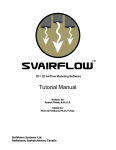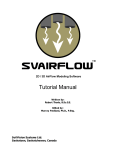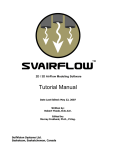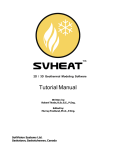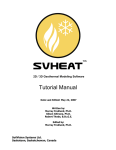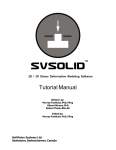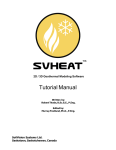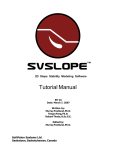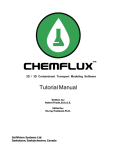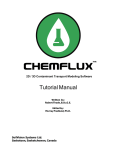Download SVAirFlow Tutorial Manual
Transcript
2D / 3D AirFlow Modeling Software Tutorial Manual Written by: Robert Thode, B.Sc.G.E. Edited by: Murray Fredlund, Ph.D., P.Eng. SoilVision Systems Ltd. Saskatoon, Saskatchewan, Canada Software License The software described in this manual is furnished under a license agreement. The software may be used or copied only in accordance with the terms of the agreement. Software Support Support for the software is furnished under the terms of a support agreement. Copyright Information contained within this Tutorial Manual is copyrighted and all rights are reserved by SoilVision Systems Ltd. The SVAIRFLOW software is a proprietary product and trade secret of SoilVision Systems. The Tutorial Manual may be reproduced or copied in whole or in part by the software licensee for use with running the software. The Tutorial Manual may not be reproduced or copied in any form or by any means for the purpose of selling the copies. Disclaimer of Warranty SoilVision Systems Ltd. reserves the right to make periodic modifications of this product without obligation to notify any person of such revision. SoilVision does not guarantee, warrant, or make any representation regarding the use of, or the results of, the programs in terms of correctness, accuracy, reliability, currentness, or otherwise; the user is expected to make the final evaluation in the context of his (her) own problems. Trademarks Windows™ is a registered trademark of Microsoft Corporation. SoilVision® is a registered trademark of SoilVision Systems Ltd. SVOFFICE ™ is a trademark of SoilVision Systems Ltd. SVFLUX ™ is a trademark of SoilVision Systems Ltd. CHEMFLUX ™ is a trademark of SoilVision Systems Ltd. SVAIRFLOW ™ is a trademark of SoilVision Systems Ltd. SVHEAT ™ is a trademark of SoilVision Systems Ltd. SVSOLID ™ is a trademark of SoilVision Systems Ltd. SVSLOPE ™ is a trademark of SoilVision Systems Ltd. ACUMESH ™ is a trademark of SoilVision Systems Ltd. FlexPDE® is a registered trademark of PDE Solutions Inc. Copyright © 2008 by SoilVision Systems Ltd. Saskatoon, Saskatchewan, Canada ALL RIGHTS RESERVED Printed in Canada Table of Contents ................................................................................................................................... 1 Introduction ................................................................................................................................... 2 A Two-Dimensional Example Model ................................................................................................................................... 2.1 Model Setup ................................................................................................................................... 2.2 Results & Discussion ................................................................................................................................... 3 A Three-Dimensional Example Model ................................................................................................................................... 3.1 Model Setup ................................................................................................................................... 3.2 Results & Discussion ................................................................................................................................... 4 References 3 of 24 4 5 5 13 14 14 22 24 Introduction 1 4 of 24 Introduction The Tutorial Manual serves a special role in guiding the first time users of the SVAIRFLOW software through a typical example problem. The example is "typical" in the sense that it is not too rigorous on one hand and not too simple on the other hand. The Tutorial Manual serves as a guide by: i) assisting the user with the input of data necessary to solve the boundary value problem, ii) explaining the relevance of the solution from an engineering standpoint, and iii) assisting with the visualization of the computer output. An attempt has been made to ascertain and respond to questions most likely to be asked by first time users of SVAIRFLOW. It should be noted that some models presented in this manual can be run with the free STUDENT authorization of the software. Other models require a purchased LITE, STANDARD, or PROFESSIONAL authorization level to run through the tutorial. The authorization level required for each model is specified at the start of the model. A Two-Dimensional Example Model 2 5 of 24 A Two-Dimensional Example Model The following example will introduce some of the features included in SVAIRFLOW and will set up a model of a simple air injection well. The purpose of this model is to determine the effects of a clay layer on the air pressure contours around an injection well. The well dimensions have been exaggerated for simplicity and viewing purposes. The model dimensions and material properties are provided below. Project: WellPumping Model: SingleWellwClay Minimum authorization required: STUDENT Model Description and Geometry Material Properties Sand: air conductivity, ka = 2.18E-04 m/s Clay: air conductivity, ka = 2.18E-05 m/s 2.1 Model Setup In order to set up the model described in the preceding section, the following steps will be required. The steps fall under the general categories of: a. Create model b. Enter geometry A Two-Dimensional Example Model c. Specify initial conditions d. Specify boundary conditions e. Apply material properties f. Specify Model Output g. Run Model h. Visualize Results 6 of 24 a. Create Model The following steps are required to create the model: 1. Open the SVOFFICE Manager dialog, 2. Select "ALL" under the Applications combo box and "ALL" for the Model Origin combo box, 3. Create a new project called UserTutorial by pressing the New button next to the list of projects. If the project is already present select it, 4. Create a new model called User_SingleWellwClay by pressing the New button next to the list of models. The new model will be automatically added under the recently created UserTutorial project, 5. Select the following: Application: SVAIRFLOW System: 2D Vertical Type: Steady-State Units: Metric Time Units: Seconds (s) Before entering any model geometry it is best to set the World Coordinate System to ensure that the model will fit in the drawing space. The user may access the World Coordinates System dialog by selecting the World Coordinates System tab on the Create New Model dialog. 1. Access the World Coordinate System tab on the Create New Model dialog, 2. Enter the World Coordinates System coordinates shown below into the dialog, 3. x - minimum: -5 y - minimum: -5 x - maximum: 55 y - maximum: 55 Click OK to close the dialog. The workspace grid spacing needs to be set to aid in defining region shapes. The SandyRegion region of the model has coordinates of a precision of 0.5m. In order to effectively draw geometry with this precision using the mouse, the grid spacing must be set to a maximum of 0.5. A Two-Dimensional Example Model 1. The View Options dialog should automatically appear, 2. Enter 0.5 for both the horizontal and vertical spacing, 3. Click OK to close the dialog. 7 of 24 b. Enter Geometry This model will be divided into two regions, which are named SandyRegion and ClayRegion. Each region will have separate material properties. To add the necessary region node points follow these steps: 1. Open the Regions dialog by selecting Model > Geometry > Regions from the menu, 2. Change the first region name from R1 to SandyRegion. To do this, highlight the name and type new text, 3. Press the New button to add a second region, 4. Change the name of the second region to ClayRegion, 5. Click OK to close the dialog. The shapes that define each material region will now be created. Note that when drawing geometry shapes, the region that is current in the region selector is the region the geometry will be added to. The Region Selector is at the top of the workspace. SandyRegion X 0 50 50 27.5 27.5 27.5 22.5 22.5 22.5 0 ClayRegion Y 0 0 50 50 35 30 30 35 50 50 Boundary Condition BN_R1_758278157 X 0 50 50 0 Y 28 28 26 26 Boundary Condition BN_ClayRegion_707530074 WellScreen End Geometry in the SVOFFICE software may be i) typed in manually, ii) cut and pasted from Excel, iii) imported from AutoCAD, or iv) drawn graphically using the CAD window. In this example we will provide instruments for drawing the geometry using the CAD window. Prior to drawing geometry shapes it is good to ensure that snappy is turned on by clicking the "Snap On" at the bottom of the drawing space. · Define the SandyRegion 1. Ensure the SandyRegion region is current in the region selector drop-down, A Two-Dimensional Example Model 2. 8 of 24 Select Draw > Model Geometry > Region Polygon from the menu or press the toolbar button, 3. Move the cursor near (0,0) in the drawing space and left-click the button to initiate drawing the shape. You can view the coordinates of the current position the mouse is at in the status bar just below the drawing space, 4. Now move the cursor to subsequent points on the region, clicking once on each region point, 5. For the last point, move the cursor near the point (0,50) and double-click on the point to finish the shape. A line is now drawn from (22.5,50) to (0,50) and the shape is automatically finished by SVAIRFLOW by drawing a line from (0,50) back to the start point, (0,0), If the SandyRegion geometry has been entered correctly the shape should look like the model diagram at the beginning of this tutorial. NOTE: If a mistake was made entering the coordinate points for a shape, edit the shape using the Region Properties dialog (menu item Model > Geometry > Region Properties). Please also see the following sections in the user's manual to undo changes, move a point, move multiple points, delete points, or subdivide a line segment. · Define the ClayRegion 6. Ensure that ClayRegion is current in the region selector, 7. Select Draw > Model Geometry > Region Polygon from the menu, 8. Move the cursor near (0,28) in the drawing space and left click, 9. To select the point as part of the shape left click on the point, 10. Now move the cursor near (50,28) and left click on the point. A line is now drawn from (0,28) to (50,28), 11. Repeat the process for the rest of the points in the region, 12. For the final point, move the cursor near the point (0,26) and double-click on the point to finish the shape. A line is now drawn from (50,26) to (0,26) and the shape is automatically finished by SVAIRFLOW by drawing a line from (0,26) back to the start point, (0,0). NOTE: At times it may be tricky to snap to a grid point that is near a line defined for a region. Turn the object snap off by clicking on "OSNAP" in the status bar to alleviate A Two-Dimensional Example Model 9 of 24 this problem. c. Specify Initial Conditions A temperature of 15oC is required for the specification of initial conditions. Initial conditions can be specified through the following steps: 1. Select Model > Initial Conditions > Settings from the menu, 2. Move to the Temperature tab, 3. Select the "Constant/Expression Temperature Option", 4. Enter a temperature value of 15, 5. Click OK to close the Initial Conditions dialog. d. Specify Boundary Conditions Boundary conditions must be applied to region points. Once a boundary condition is applied to a boundary point the starting point is defined for that particular boundary condition. The boundary condition will then extend over subsequent line segments around the edge of the region in the direction in which the region shape was originally entered. Boundary conditions remain in effect around a shape until re-defined. The user cannot define two different boundary conditions over the same line segment. More information on boundary conditions can be found in Menu System > Model Menu > Boundary Conditions > 2D Boundary Conditions in your User's Manual. Now that all of the regions and the model geometry have been successfully defined, the next step is to specify the boundary conditions. An atmospheric pressure of 101.2 kPa is applied at the ground surface and a pressure of 101.3 kPa is applied at the base of the model to provide a small gradient. The injection well pressure is 102 kPa. X 0 50 50 27.5 27.5 27.5 22.5 22.5 22.5 0 Y 0 0 50 50 35 30 30 35 50 50 Boundary Condition Pressure Expression = 101.3 kPa Zero Flux Pressure Expression = 101.2 kPa Zero Flux Pressure Expression = 102 kPa Continue Continue Zero Flux Pressure Expression = 101.2 kPa Zero Flux The steps for specifying the boundary conditions are thus: · SandyRegion 1. Select the "SandyRegion" region in the drawing space, 2. From the menu select Model > Boundaries > Boundary Conditions. The boundary conditions dialog will open. By default the first boundary segment will be given a Zero Flux condition. The user may also press the toolbar button, A Two-Dimensional Example Model 10 3. Select "Pressure Expression" from the Boundary Condition drop-down, 4. Select the point (0,0), 5. Enter 101.3 in the Expression field, 6. Select the point (50,0) from the list, 7. Select the "Zero Flux" condition from the drop-down, 8. Apply the remaining boundary conditions referring to the list above, 9. Click the OK button to close the dialog. of 24 NOTE: The Pressure Expression boundary condition for the point (27.5,50) becomes the boundary condition for the following line segments that have a Continue boundary condition until a new boundary condition is specified. In this case the line segments from (27.5,50) to (22.5,35) are all given a zero flux boundary condition. · ClayRegion By default a Zero Flux boundary condition is set for the ClayRegion region and this boundary condition is appropriate so no specifications are required. e. Apply Material Properties The next step in defining the model is to enter the material properties for the two materials that will be used in the model. A sand is defined for the majority of the model and a clay layer extends horizontally through the middle. This section will provide instructions on creating the sand material. Repeat the process to add the clay material. 1. Open the Materials dialog by selecting Model > Materials > Manager from the menu, 2. Click the New button to create a material, 3. Enter Sand for the material name in the dialog which appears, 4. Press OK to close the dialog. The Material Properties dialog will open automatically, NOTE: When a new material is created, you can specify the display color of the material using the Fill Color box on the Material Properties menu. Any region that has a material assigned to it will display that material's fill color. 5. Move to the Conductivity tab and select "Constant/Expression" from the drop- 6. Enter the k a value of 2.18E-04 m/s, 7. Click OK to close the Material Properties dialog, 8. Repeat these steps to create the clay material; refer to the data provided in the down, A Two Dimensional Example Model section at the beginning of this tutorial, 9. Press OK to close the Materials Manager dialog, 10. Open the Regions dialog by selecting Model > Geometry > Regions from the A Two-Dimensional Example Model 11 of 24 menu, 11. Select the "Sand Material" for the SandySoil using the material drop-down, 12. Select the "Clay Material" for the ClayLayer using the material drop-down, 13. Press the OK button to accept the changes made and close the Regions dialog. f. Specify Analysis Settings Two levels of output may be specified: i) output (graphs, contour plots, fluxes, etc.) which are displayed during model solution, and ii) output which is written to a standard finite element file for viewing with ACUMESH software. Output is specified in the following two dialogs in the software: i) Plot Manager: ii) Output Manager: Output displayed during model solution. Standard finite element files written out for visualization in ACUMESH or for inputting to other finite element packages. PLOT MANAGER The Plot Manager dialog is first opened to display appropriate solver graphs. Boundary Flux specifications are used to report the rate of flow across a boundary for a steady state analysis and the rate and volume of flow moving across a boundary in a transient analysis. Boundary Names must be assigned using the Region Properties dialog and then Reports selected using the Boundary Flux dialog. 1. Click on the SandyRegion region shape in the workspace with the mouse, 2. Select Model > Boundaries > Boundary Conditions from the menu to open the Boundary Conditions dialog. By default the point (0,0) has a Boundary Name defined, 3. Select the point (27.5,35), 4. Enter the boundary name WellScreen, 5. Select point (22.5,35) from the list, 6. Enter End as the boundary name, 7. Press OK to close the dialog. Once the Boundary Names have been defined, the plots can be defined. 1. Select Model > Reporting > Plot Manager from the menu to open the Plot Manager dialog, 2. Select the Boundary Flux tab and press the Report button, 3. Select "WellScreen" as the boundary and enter WellScreen as the title, 4. Select the Output Options tab and click the checkbox beside PLOT, 5. Press OK to return to the Plot Manager dialog, 6. Press the History Plot button on the Boundary Flux tab, 7. Select "WellScreen" as the boundary, enter BF: WellScreen - X Component of Flow as the title, and select X Component of Flow as the variable, 8. Select the Output Options tab and ensure both checkboxes are unchecked, 9. Press OK to return to the Plot Manager dialog, A Two-Dimensional Example Model 12 of 24 10. Press the History Plot button on the Boundary Flux tab, 11. Select "WellScreen" as the boundary, enter BF: WellScreen - Y Component of Flow as the title, and select Y Component of Flow as the variable, 12. Select the Output Options tab and ensure both checkboxes are unchecked, 13. Press OK to return to the Plot Manager dialog, 14. Press the History Plot button on the Boundary Flux tab, 15. Select WellScreen as the boundary, enter BF: WellScreen - Normal Flow as the title, and select Normal Flow as the variable, 16. Select the Output Options tab and ensure both checkboxes are unchecked, 17. Press OK to return to the Plot Manager dialog, 18. Click OK to close the Plot Manager dialog and return to the workspace. There are many plot types that can be specified to visualize the results of the model. A few will be generated for this tutorial example model including a plot of the solution mesh, air pressure contours, and flux vectors. These plots may be automatically generated by pressing the Default Plots button. OUTPUT MANAGER 1. Open the Output Manager dialog by selecting Model > Reporting > Output Manager from the menu, 2. The toolbar at the bottom left corner of the dialog contains a button for each output file type. Click on the ACUMESH button to begin adding the output file, The Output File Properties dialog will open, 3. Click OK to close the dialog and add the output file to the list, 4. Click OK to close the Output Manager and return to the workspace. g. Run Model The next step is to analyze the model. Select Solve > Analyze from the menu. This action will write the descriptor file and open the FlexPDE solver. The solver will automatically begin solving the model. A Two-Dimensional Example Model 13 of 24 h. Visualize Results The visual results for the current model may be examined by selecting the View > ACUMESH menu option or clicking on the ACUMESH button 2.2 on the processes toolbar. Results & Discussion A contour plot of the completed model results can be seen below. All outputs previously specified can now be visualized using ACUMESH. It can be seen from the following results that the clay layer inhibits the flow of air. Lateral flow in the air is therefore unlikely in this instance. A Three-Dimensional Example Model 3 14 of 24 A Three-Dimensional Example Model The following example will introduce you to the three dimensional SVAIRFLOW modeling environment. The purpose of this model is to calculate the quantity of air-flow into the basement. A 1 cm crack exists between the floor slab and the basement walls. The intent of the current model is to calculate the volume of contaminated air which will enter the basement in these specific conditions. Project: Foundations Model: FloorLeak Minimum authorization required: FULL Model Description and Geometry 3.1 Model Setup In order to set up the model described in the preceding section, the following steps will be required. The steps fall under the general categories of: a. Create model b. Enter geometry c. Specify initial conditions d. Specify boundary conditions A Three-Dimensional Example Model e. Apply material properties f. Specify Model Output g. Run model h. Visualize results 15 of 24 a. Create Model Since FULL authorization is required for this tutorial, the user must perform the following steps to ensure full authorization is activated: 1. Plug in the USB security key, 2. Go to the File > Authorization dialog on the SVOFFICE Manager, 3. Software should display full authorization. If not, it means that the security codes provided by SoilVision Systems at the time of purchase have not yet been entered. Please see the the Authorization section of the SVOFFICE User's Manual for instructions on entering these codes. The following steps are required to create the model: 1. Open the SVOFFICE Manager dialog, 2. Select the project called UserTutorial by pressing the New button next to the list of projects, 3. Create a new model called UserFloorLeak by pressing the New button next to the list of models. The new model will be automatically added under the recently created UserTutorial project. The first step in defining the model is to specify the settings that will be used for the model. To open the Settings dialog select Model > Settings in the workspace menu. Select the following settings: Application: SVAIRFLOW System: 3D Vertical Type: Steady-State Units: Metric Time Units: Seconds (s) Before entering any model geometry it is best to set the World Coordinate System to ensure that the model will fit in the drawing space. The user may access the World Coordinates System dialog by selecting the World Coordinates System tab on the Create New Model dialog. 1. Access the World Coordinate System tab on the Create New Model dialog, 2. Enter the World Coordinates System coordinates shown below into the dialog, x - minimum: 45 y - minimum: 45 x - maximum: 75 y- maximum: 75 16 A Three-Dimensional Example Model 3. of 24 Click OK to close the dialog. b. Enter Geometry A region in SVAIRFLOW is the basic building block for a model. A region represents both a physical portion of material being modeled and a visualization area in the SVAIRFLOW CAD workspace. A region will have a set of geometric shapes that define its material boundaries. Also, other modeling objects including features, flux sections, text, and line art can be defined on any given region. This model will be defined by three regions, which are named Outer, Basement, and Crack. To add the necessary regions follow these steps: 1. Open the Regions dialog by selecting Model > Geometry > Regions from the menu, 2. Change the first region name from R1 to Outer. To do this, highlight the name and type new text, 3. Press the New button to add a second region, 4. Change the name of the second region to Basement, 5. Press the New button to add a third region, 6. Change the name of the third region to Crack, 7. Click OK to close the dialog. The shapes that define each region will now be created. Note that when drawing geometry shapes the region that is current in the region selector is the region the geometry will be added to. The Region Selector is at the top of the workspace. Outer X 50 70 70 50 · Basement Y 50 50 70 70 X 50 59.8 59.8 50 Y 50 50 59.8 59.8 Crack X 50 59.7 59.7 50 Y 50 50 59.7 59.7 Define the Outer region 1. Ensure the Outer region is current in the region selector, 2. Select Draw > Model Geometry > Polygon Region from the menu, 3. Move the cursor near (50,50) in the drawing space, 4. When the cursor is near the point, click the left mouse button. The cursor should automatically snap to the point (50,50) as long as the SNAP and GRID options in the status bar are both bold, 5. Now move the cursor to subsequent region points and repeat the left-click procedure, 6. For the last point (50,70), double-click on the point to finish the shape. A line is now drawn from (70,70) to (50,70) and the shape is automatically finished by SVAIRFLOW by drawing a line from (50,70) back to the start point, (50,50). A Three-Dimensional Example Model 17 of 24 NOTE: Select a shape with the mouse and select Edit > Delete from the menu if a mistake was made entering the coordinate points for a shape. This will remove the entire shape from the region. To edit the shape use the Region Properties dialog. · Define the Basement In the instructions for defining the Outer shape the command line was used. To draw the Basement region the instructions below explain the use of the drawing tool to create the Basement shape. 7. Select Model > Geometry > Regions from the menu, 8. Select the "Basement" region and click the Properties button, 9. Click the New Polygon button, 10. Enter the region points as shown in the above table, 11. Click OK to save the region geometry and close the Region Properties dialog. · Define the Crack Follow the above method to define the Crack shape, referring to the table of points above. After all the region geometry has been entered it will appear like the diagram at the beginning of this tutorial. This model consists of three surfaces defined by constant elevations. By default every model initially has two surfaces. · Define Surface 1 This surface will be defined by providing a constant elevation. 1. Select "Surface 1" in the Surface Selector located at the top of the workspace, 2. Select Model > Geometry > Surface Properties in the menu to open the Surface Properties dialog, · 3. For the Surface Definition option, select "Constant", 4. Enter a Surface Constant of 0, 5. Click OK to close the dialog, Define Surface 2 This surface will be defined by providing a constant elevation. 6. Select "Surface 2" in the Surface Selector located at the top of the workspace, 7. Select Model > Geometry > Surface Properties in the menu to open the Surface Properties dialog, 8. For the Surface Definition option, select "Constant", 9. Enter a Surface Constant of 4, 10. Click OK to close the dialog. · Insert and Define Surface 3 Surface 3 is not present by default and must be created using the Insert Surface dialog. A Three-Dimensional Example Model 1. 18 of 24 Open the Surfaces dialog by selecting Model > Geometry > Surfaces from the menu. Press the New button to add surfaces, 2. 1 is selected in the Number of New Surfaces dialog and press OK to add "Surface 3" and close the dialog, 3. Click OK to close the Insert Surface dialog, 4. Select Surface 3 in the Surfaces dialog and click the Properties button, 5. For the Surface Definition option, select "Constant", 6. Enter a Surface Constant of 5.5, 7. Click OK to close the dialog. c. Specify Initial Conditions A temperature of 20oC is required. 1. Select Model > Initial Conditions > Settings from the menu, 2. Move to the Temperature tab, 3. Select the "Constant/Expression Temperature" Option, 4. Enter a temperature value of 20, 5. Click OK to close the Settings dialog. d. Specify Boundary Conditions Boundary conditions must be applied to region points. Once a boundary condition is applied to a boundary point this defines the starting point for that particular boundary condition. The boundary condition will then extend over subsequent line segments around the edge of the region in the direction in which the region shape was originally entered. Boundary conditions remain in effect around a shape until re-defined. The user may not define two different boundary conditions over the same line segment. More information on boundary conditions can be found in Menu System > Model Menu > Boundary Conditions > 2D Boundary Conditions in your User's Manual. Now that all of the regions, surfaces, and the materials have been successfully defined, the next step is to specify the boundary conditions on the region shapes. The ground surface will be set at a pressure of 101.3 kPa while the basement will be set at a pressure of 101.2 kPa. The steps for specifying the boundary conditions include: 1. Select the "Outer" region in the drawing space, 2. Select "Surface 3" in the surface selector, 3. From the menu select Model > Boundaries > Boundary Conditions. The boundary conditions dialog will open and display the boundary conditions for Surface 3, 4. Move to the Surface Boundary Conditions tab, 5. From the Boundary Condition drop-down select a Pressure Expression boundary condition. This will cause the Expression box to be enabled, 6. In the Expression box enter a pressure of 101.3, A Three-Dimensional Example Model 7. 19 of 24 Click the OK button to save the boundary condition to the list. Now, to set the Crack regions Surface 2 Boundary Condition to 101.2 kPa: 1. Select the "Crack" region in the drawing space, 2. Select "Surface 2" from the surface drop-down, 3. From the menu select Model > Boundaries > Boundary Conditions, 4. Click the Surface Boundary Conditions tab, 5. Select the Pressure Expression boundary condition and enter a value of 101.2 in the expression box, 6. Close the dialog using the OK button. NOTE: The remaining Surfaces are by default set to the None boundary condition, which is treated as a Zero Flux condition. The remaining Segments are by default set to the No B C boundary condition, which also is treated as a Zero Flux condition. e. Apply Material Properties The next step in defining the model is to enter the material property for the material that will be used in the model. It will be defined for all the regions. 1. Open the Materials Manager dialog by selecting Model > Materials > Manager from the menu, 2. Click the New button to create a material. Enter "Soil1" for the name, 3. The Material Properties dialog will open automatically; or, select the new material and click Properties to open the Material Properties dialog, 4. Move to the Conductivity tab, 5. Enter the k a expression of 7E-08*(z/5.5) m/s. This expression will cause the air conductivity to vary with depth, z, 6. Press OK on the Materials Manager dialog to close both dialogs. Each region will cut through all the layers in a model creating a separate block on each layer. Each block can be assigned a soil or be left as void. A void area is essentially air space. In this model all blocks will be assigned a material. 1. Select "Outer" in the Region Selector, 2. Select Model > Materials > Material Layers from the menu to open the Material Layers dialog, 3. Select the "Soil1" material from the drop-down for Layer 1, 4. Select the "Soil1" material from the drop-down for Layer 2, 5. Select "Basement" in the Region Selector using the right arrow at the top of the Material Layers dialog, A Three-Dimensional Example Model 6. 20 of 24 Select Model > Materials > Material Layers from the menu to open the Material Layers dialog, 7. Select the "Soil1" material from the drop-down for Layer 1, 8. Select "Crack" in the Region Selector, 9. Select Model > Materials > Material Layers from the menu to open the Material Layers dialog, 10. Select the "Soil1" material from the drop-down for Layer 1, 11. Close the dialog using the OK button. f. Specify Model Output Two levels of output may be specified: i) output (graphs, contour plots, fluxes, etc.) which are displayed during model solution, and ii) output which is written to a standard finite element file for viewing with ACUMESH software. Output is specified in the following two dialogs in the software: i) Plot Manager: ii) Output Manager: Output displayed during model solution. Standard finite element files written out for visualization in ACUMESH or for inputting to other finite element packages. PLOT MANAGER The Plot Manager dialog is first opened to display appropriate solver graphs. There are many plot types that can be specified to visualize the results of the model. A few will be generated for this tutorial example model including a plot of the pressure contours, solution mesh, and gradient vectors. 1. Open the Plot Manager dialog by selecting Model > Reporting > Plot Manager from the menu, 2. The toolbar at the bottom left of the dialog contains a button for each plot type. Click on the Contour button to begin adding the first contour plot. The Plot Properties dialog will open, 3. Enter the title air pressure. 4. Select ua as the variable to plot from the drop-down, 5. Select the PLOT output option, 6. Move to the Projection tab, 7. Select "Plane Projection" option, 8. Select Y from the Coordinate Direction drop-down, 9. Enter 50 in the Coordinate field. This will generate a 2D slice at y = 50m on which the air pressures will be plotted, 10. Click OK to close the dialog and add the plot to the list, 11. Repeat these steps 2 to 10 to create the remaining plots. Note that the Mesh plot does not require entry of a variable, 12. Click OK to close the Plot Manager and return to the workspace, A Three-Dimensional Example Model 21 of 24 In order to find out the amount of air flowing into the basement, we must define a surface flux across the Surface 2 (the basement floor) and restrict it to the BasementIn region. Follow these steps to define this: 13. Open the Plot Manager dialog by selecting Model > Reporting > Plot Manager from the menu, 14. Select the Surface Flux tab and press the Summary Plot button from the Add New Plot area, 15. The Plot Properties - Surface Flux dialog will appear. Select "Surface 2" from the Surface drop-down, 16. Type in Crack Flow as the name of the Surface Flux and Restrict to Region Basement. Additional plots may be defined by pressing the Default Plots button on the Plot Manager. OUTPUT MANAGER Two types of output files will be generated for this tutorial example model: a transfer file of air pressure, and a .dat file to transfer the results to ACUMESH. 1. Open the Output Manager dialog by selecting Model > Reporting > Output Manager from the menu, 2. The toolbar at the bottom left corner of the dialog contains a button for each output file type. Click on the ACUMESH button to begin adding the output file. The Output File Properties dialog will open, 3. Enter the title Basement2, 4. Click OK to close the dialog and add the output file to the list, 5. Press the Transfer File button to create a new transfer file, 6. Enter the title uaTransfer, 7. Select the variable ua in the available variables list, 8. Press the Single Right Arrow button, 9. Click OK to close the dialog and add the output file to the list, A Three-Dimensional Example Model 22 of 24 10. Click OK to close the Output Manager and return to the workspace. g. Run Model The next step is to analyze the model. Select Solve > Analyze from the menu. This action will write the descriptor file and open the SVAIRFLOW solver. The solver will automatically begin solving the model. When the Regrid Limit message appears click "No" and the solver will begin generating the plots. h. Visualize Results Once you have analyzed the model, the output plots can be visualized using ACUMESH. In order to view plots in ACUMESH, select Window > ACUMESH from the menu.ACUMESH will prompt you to select the "Output file" to view. Choose ACUMESHOut.dat and click OK to open this file. Plots can visualized by selecting the desired process under Plots in the menu. 3.2 Results & Discussion After the model has finished solving, the results will be displayed in the dialog of thumbnail plots within the SVAIRFLOW solver. These plots can also be examined in details using ACUMESH. This section will give a brief analysis for each plot that was generated. · Solution Mesh The Mesh plot displays the finite-element mesh generated by the solver. The mesh is automatically refined in critical areas. · Pressure Contours A Three-Dimensional Example Model 23 of 24 The plot indicates a pressure gradient causing flow of air into the basement. The results of the flux section indicate the steady-state flow of air of 4.80e-7 m 3/second, equivalent to 0.0415 m 3/day is entering the basement. References 4 24 of References FlexPDE 5.x Reference Manual, 2007. PDE Solutions Inc. Spokane Valley, WA 99206. 24
























